
Welcome to kalamazoosnakes.com! I am David, a snake enthusiast living in Kalamazoo, MI. Many people don't know that Kalamazoo is in fact full of snakes! You just need to know where to find them - they can often be shy and elusive. Some Michigan snake species are more common outside of the city limits, in different parts of Kalamazoo County MI, but many types of snakes are indeed common in the more urban parts of Kalamazoo. This guide is meant to help educate you about the beautiful snakes of Kalamazoo, and to help you identify the most common snakes of Kalamazoo, as well as the venomous snakes of Kalamazoo that you should learn to recognize and avoid. If you want more detail, click here for my complete list of ALL snake species in Kalamazoo. Remember the following:
- Most snakes of Kalamazoo are harmless and don't want to encounter you
- Venomous snakes exist but are uncommon in Kalamazoo, Michigan
- Snakes eat rats and mice and are a valuable part of the Michigan ecosystem
- Never kill a snake - if you leave a snake alone, it will leave you alone.
Common Snake Species in Kalamazoo
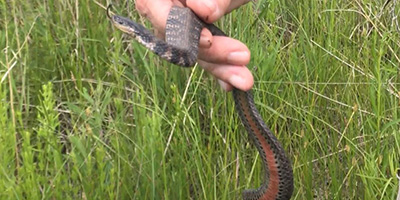 Kirtland's Snake:
This snake is rather small reaching up to 24 inches when they are adults, averaging at 18 inches.
Their color goes from a reddish to dark brown with four rows of alternating dark round blotches on their sides and back. There is also a faint stripe found along the middle of the back.
One of their key characteristics is the color of their belly, which is either bright red, pink, or orange, bordered by two parallel rows of black spots.
Currently, the Kirtland’s snake is endangered in the state and is being legally protected in the area.
Kirtland's Snake:
This snake is rather small reaching up to 24 inches when they are adults, averaging at 18 inches.
Their color goes from a reddish to dark brown with four rows of alternating dark round blotches on their sides and back. There is also a faint stripe found along the middle of the back.
One of their key characteristics is the color of their belly, which is either bright red, pink, or orange, bordered by two parallel rows of black spots.
Currently, the Kirtland’s snake is endangered in the state and is being legally protected in the area.
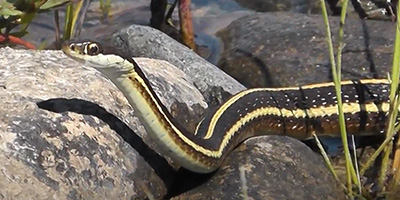 Eastern Ribbon Snake:
The ribbon snake appears to have a slender body with three light stripes (usually in the color yellow); two of them along each side and one down the center of the body which is often dark.
While they generally resemble the garter snake, they are slender in form and have lateral stripes in scale rows of 3 or 4. They also have a plain yellowish belly as well as keeled scales.
These snakes often feed on small fishes and amphibians and spend time in the water. Although they are a common sight, they aren’t exactly protected in most states they are found in.
Eastern Ribbon Snake:
The ribbon snake appears to have a slender body with three light stripes (usually in the color yellow); two of them along each side and one down the center of the body which is often dark.
While they generally resemble the garter snake, they are slender in form and have lateral stripes in scale rows of 3 or 4. They also have a plain yellowish belly as well as keeled scales.
These snakes often feed on small fishes and amphibians and spend time in the water. Although they are a common sight, they aren’t exactly protected in most states they are found in.
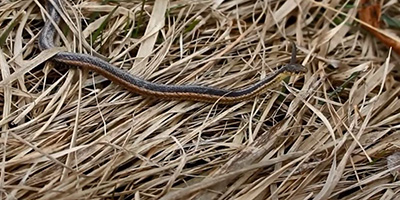 Butler's Garter Snake:
The butler’s garter snake is identifiable through their pattern consisting of three well-defined yellow, orange, and cream-colored stripes running along the length of their body -which is commonly black, brown, or olive-brown.
Sometimes, they would also have two rows of dark spots that run down their back between the central stripe and the other two stripes on the sides.
These snakes are mostly in wetlands that are open or semi-open. Areas with heavy thatch layers are essential to them because it allows them to search for food while keeping away from their predators.
Butler's Garter Snake:
The butler’s garter snake is identifiable through their pattern consisting of three well-defined yellow, orange, and cream-colored stripes running along the length of their body -which is commonly black, brown, or olive-brown.
Sometimes, they would also have two rows of dark spots that run down their back between the central stripe and the other two stripes on the sides.
These snakes are mostly in wetlands that are open or semi-open. Areas with heavy thatch layers are essential to them because it allows them to search for food while keeping away from their predators.
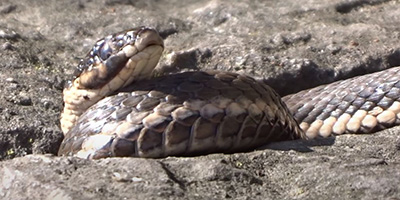 Queen Snake:
The queen snake is one of the non-venomous species found in the area. They are an aquatic species which is why they are commonly found near rivers, streams, or lakes with good water quality.
Their bodies are usually an olive-brown color with three dark stripes that run down the back. Their belly is often a pale yellow color with four dark stripes running along the length. This is a key characteristic because of the unique stripes on their belly.
This species, however, has been noted as endangered. It mostly stems from habitat loss due to disturbance of waterways, urban development, and pollution.
Queen Snake:
The queen snake is one of the non-venomous species found in the area. They are an aquatic species which is why they are commonly found near rivers, streams, or lakes with good water quality.
Their bodies are usually an olive-brown color with three dark stripes that run down the back. Their belly is often a pale yellow color with four dark stripes running along the length. This is a key characteristic because of the unique stripes on their belly.
This species, however, has been noted as endangered. It mostly stems from habitat loss due to disturbance of waterways, urban development, and pollution.
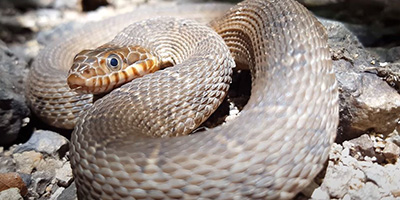 Plain Bellied Water Snake:
An adult plain-bellied water snake can reach up to 48 inches in length. Their bodies are thick and greenish-gray or reddish-brown color with no pattern. Their belly, neck, and lip scales are usually yellow or reddish-orange.
This species is non-venomous, but they tend to fight back when they encounter threats around them. Although, they are not aggressive and mostly avoid direct contact.
These snakes are often located close to bodies of water such as rivers, lakes, ponds, swamps, springs, and even cypress stands.
Plain Bellied Water Snake:
An adult plain-bellied water snake can reach up to 48 inches in length. Their bodies are thick and greenish-gray or reddish-brown color with no pattern. Their belly, neck, and lip scales are usually yellow or reddish-orange.
This species is non-venomous, but they tend to fight back when they encounter threats around them. Although, they are not aggressive and mostly avoid direct contact.
These snakes are often located close to bodies of water such as rivers, lakes, ponds, swamps, springs, and even cypress stands.
Venomous Snake Species in Kalamazoo
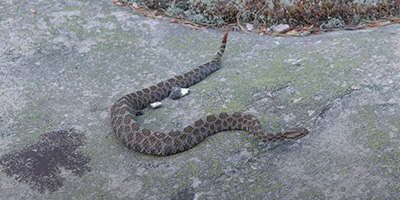 Massasauga Rattlesnake:
In Michigan, the massasauga rattlesnake is considered a part of the state’s heritage mainly because it’s the only venomous snake located in the area.
Generally, they are associated with wetland habitats. Although they prefer woody debris or vegetation to keep themselves hidden -which comes from their secretive behavior.
They are heavy-bodied, colored gray or grayish-brown with dark blotches and spots down the back and sides. Their belly would usually be blackish with no patterns.
Massasauga Rattlesnake:
In Michigan, the massasauga rattlesnake is considered a part of the state’s heritage mainly because it’s the only venomous snake located in the area.
Generally, they are associated with wetland habitats. Although they prefer woody debris or vegetation to keep themselves hidden -which comes from their secretive behavior.
They are heavy-bodied, colored gray or grayish-brown with dark blotches and spots down the back and sides. Their belly would usually be blackish with no patterns.
If you're unsure, you can email me a photo of the snake at info@kalamazoosnakes.com and I will email you back with the snake's species. If you found a snake skin, read my Found a Skin? page, and you can email me a photo of the skin, and I'll identify the snake for you. If you need professional Kalamazoo snake removal help, click my Get Help page, or see the below website sponsor I found, who provides that service.
Remember, the term is not poisonous snakes of Kalamazoo, it's venomous snakes of Kalamazoo. Poison is generally something you eat, and venom is injected into you. That said, dangerous snakes are very rare in Kalamazoo. The few venomous snakes of Kalamazoo County are rarely seen. But they are commonly misidentified, so learn about all the snake species of Kalamazoo in order to correctly identify them. These snakes are usually also found in the surrounding towns of Portage, Kalamazoo Township, Vicksburg, Galesburg, Richland, Schoolcraft, Comstock Township, Texas charter Township, Parchment, Augusta, Cooper Township, Climax, Comstock Northwest, South Gull Lake, Greater Galesburg, and the surrounding areas.
Read our article about:
Can Snake Dig Holes?
kalamazoosnakes.com domain and hosting costs made possible by the generous support of this sponsor:
